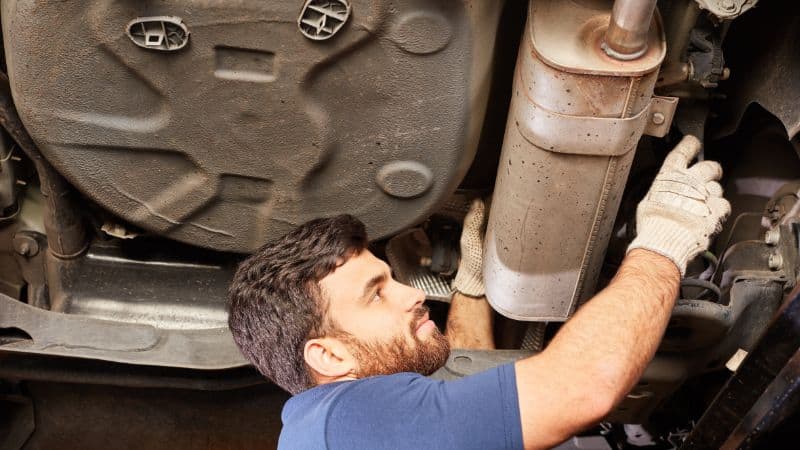A complex heating and mixing procedure is used to create fluid film. It combines raw wool wax with selective polar agents and corrosion inhibitors. After mixing, a unique lanolin-based formulation is designed to stop rust on contact.
On contact, it forms a fluid barrier that is permanently active. Due to this barrier, it won’t chip or crack, protecting exposed metals and undercoating for a long time. So, what is the benefit of using fluid film on exhaust, you may wonder? Let’s discuss the using fluid film below:
Important Information About Fluid Film on Exhaust
Fluid film made from specially selected agents, processed wool wax, and highly refined petroleum oil. Due to these properties, it can provide water displacement, corrosion control, metal wetting, and penetration.
This long-lasting product contains no solvents, will not dry out, and will penetrate all metal substrates. Most importantly, it provides corrosion protection from both natural and industrial environments.
Fluid film is going to burn that muffler every time. You can apply it when not in use to prevent any rust. But be aware that it must be reapplied once it warms up.
Vehicles in areas with heavy exposure to rain, snow, or salty air are highly vulnerable to corrosion. Basically, liquid film is perfect for protecting exhaust from rust. In other words, it works great and won’t burn your 60 if you get it in the exhaust.

How To Use Fluid Film On Exhaust?
Anywhere you can apply fluid film without near the friction surface of the brake. Whatever ends up in the exhaust or engine will burn.
Depending on your need, a fluid film comes in various viscous thicknesses and grades. 80% of the application must be applied with an aerosol, sprayer ‘hand pump’ or rag. Actually, it’s easy, fast, and long-lasting.
Before using fluid film on the exhaust, it is best to polish your car correctly because it can prevent creep. Its non-solvent application is why fluid film is an all-purpose chain lube.
To use this fluid film, you need to spray it directly into the chain. You then wipe off the excess fluid film with a clean rag. This liquid film will protect, lubricate, and transfer from rust to all places. Nonetheless, the fluid movie works well as a DIY; you must reapply it yearly. Though it is cheap, you can find better options.
No matter what you use, before using it you should wash the frame thoroughly. After cleaning it, let it dry thoroughly. Then, spray the fluid film inside thoroughly. The fantastic thing about fluid film is how thin it is regarding temperature.
Easy process Of How to Use Fluid Film:
Let’s know an easy way to use fluid film on Exhaust:
1) Drive on a tarp
2) Spray waste oil all over the bottom – do this 2 or 3 times
3) Allow the drip to reduce to a reasonable amount
4) Drive on a dirt road
5) Repeat steps 1-4
Can You Put Fluid Film On the Exhaust?
If you put fluid film on the exhaust, you’ll smell it burning for a long time. Likewise, it will burn after a few tries to turn it off if it gets on the brake rotors.
Above all, spray a few cans inside each frame rail if you are not concerned about road salt. The reason is that it would need a more involved application. Besides, plug them into the four large holes in the outer rail.
Next, spray where the body seams are, especially behind the taillights. So, if you also may know, can you spray fluid film on the exhaust? We hope you got the answer.
What Are The Reasons for Coming Out of the Water in Exhaust?
This is probably condensation from the hot exhaust going through a lot of cooling piping. Therefore, it can produce a lot of water during acceleration, which runs out. It may run for a while or the whole drive in cold weather. But on long trips, the system gets hot enough to dry.
However, if water comes from your exhaust pipe, you should notice if white smoke is coming out. And don’t worry about it. But if your exhaust leaks gasoline or water after running for a while, you should call a professional.
Water that comes out from the exhaust is only condensed water, and it forms inside the exhaust system. And it occurs mostly in cold weather. This water can be condensed due to the following reasons –
- As combustion occurs in your car’s engine, water and carbon dioxide are mixed. When the engine cools down, and exhaust gasses leave the combustion chamber, you can see water coming from your vehicle’s exhaust pipe.
- Water vapor is condensed in the catalytic converter in the exhaust pipe.
- When the engine sd heats up, the exhaust system also produces heat. After it presents itself as steam in your tailpipe.
What Are the Reasons For Cooling Out of Exhaust?
Coolant coming out of your exhaust usually has three problems. All problems should be fixed immediately to avoid further damage to your vehicle.
Head Gasket
The blown head gasket is the first culprit of coolant coming out of your exhaust. Nevertheless, you can replace the faulty head gasket at a low price to avoid coolant leaks.
The head gasket’s job is to seal the gap between the cylinder head and engine block to obstruct the air. Unfortunately, these head gaskets can occasionally fail due to faulty components.
Due to head gasket blows, small or multiple cracks can occur. This allows engine coolant to escape the engine block and enter the exhaust chamber. Thus, it’s traveling up your exhaust tailpipe.
The Head
Another severe cause of coolant leaking from your exhaust is a cracked head. Coolant leaks similarly to a blown head gasket. However, it enters through a crack in the head rather than a gasket crack. If you have this problem, you will need expensive repairs.
Intake Manifold
The critical equipment of your engine is the intake manifold. It’s because it performs many functions, and one of those functions is to direct coolant into the cylinders.
High pressure and heat are the reasons for the crack in the intake manifold or the blowing of a gasket. Sometimes, due to these cases, coolant leaks out of your exhaust. In most cases, coolant pools on the ground under the engine.
Common Queries
Q. Is Fluid Film Flammable?
It’s a wax, and wax always burns. Remember, fluid films are highly flammable. Typically, the bulk flash point is 405F with fluid film.
Avoid places with high heat when using the bulk form as a vehicle undercoating. It will burn into it anyway, so you don’t need to worry too much about it.
Q. Is Fluid Film Safe to Breathe?
Fluid film is categorized as non-hazardous and non-toxic and has less than 1% VOC content. That’s why the atmosphere can help to remove the use of ozone-depleting chemicals.
Mainly, this fluid film does not contain phenols, arsenic, solvents, heavy metals, PCs, PCBs, TCDDs, or dioxin-related substances.
Unlike competitors, since this fluid film has no harmful substances, it’s safe for skin, lungs, and health. In fact, it will not be dangerous for your breath. It won’t be sticky, tacky, or gooey and is easy to apply to achieve long-lasting success.
Notably, with proper application, Fluid films will extend the life of tools and equipment. Indeed, it can decrease maintenance costs and equipment downtime.
Q. Is Fluid Film Messy?
Does anyone want to know if the fluid film is messy? Usually, fluid film is wet. So after applying it, it will get an initial dusting. But since it has no solvent and won’t stick, it won’t form glue or won’t build up dirt.
Q. What Does Fluid Film Smell?
The fluid film smells like lanolin; it lingers for about a week after application but then disappears. Subsequently, the odor of fluid film is temporary and smells like my truck won’t rust.
Though it’s funny when it burns off the exhaust, you should remember it’s temporary. The important thing about this fluid film is that it’s not harmful to anything.
Q. How Long Does Fluid Film Drip?
The liquid film does not drop off. You can remove the grime once a year, inspect for rust or other damage, and reapply.
The liquid film is oil-based. Generally, it doesn’t harden or dry out on the undercarriage. This means that once a year, you have to bring it in for some maintenance.
Q. What is the Liquid Coming Out of My Exhaust?
If you see some liquid coming out of your exhaust, you must first determine what it is. Specifically, this type of liquid can be a petrol mixture or water.
You can notice different reasons for water or petrol coming out of your exhaust pipe. Some reasons aren’t problematic, while others can be severe issues. Follow the guidelines below to determine what is your main problem:
● If your exhaust is leaking water
In most cases, if water comes out of your exhaust pipe, it should come with white smoke. Hence, if you can determine your problem, you can fix it quickly. Water coming out of the exhaust is not a problem because it’s condensed water.
And it builds up in the drain system. When you can see white smoke coming from the exhaust pipe, you can confirm it. Nonetheless, you can solve this problem if you run your car for a while. Thus, if you experience this problem, there is nothing to worry about.
● If petrol comes out of your exhaust
If gasoline comes out of your exhaust pipe, you can notice the black smoke coming out as well. It’s a sign that indicates your combustion chamber has an incomplete burn. Excess fuel in the fuel mixture and component failure can be the culprit of this problem.
Most of the time, you don’t need to worry about it because it’s not a severe issue. Dirty air filters can cause it. That means if you don’t change your air filter for a long time, it cannot supply proper air for the mixture. In one minute, you can fix this problem easily.
These problems may occur because of a leaking fuel injector or a fuel regulator that is clogged with the fuel return line. Unluckily, if you experience any of these problems, you should call an expert to fix it. It would help if you did this immediately so the problem does not worsen.
Final Word
In summary, if your rubberized coating has become a rust trap over the years, fluid film can remove it. Yet, fluid film can also crack and make the coating obstruct rust and corrosion easily.
Ergo, fluid film on exhaust is good if there is no rust. Ultimately, it’s safe to use on all metals, it can’t stop pitting on chrome and won’t damage your plastic or paint. Even so, due to its excellent properties, it can deliver long-lasting lubricant.
However, after reading this article, we hope you can know the exact information about the fluid film. Finally, if you have any questions, please feel free to comment in the comment section. We are available for you.


